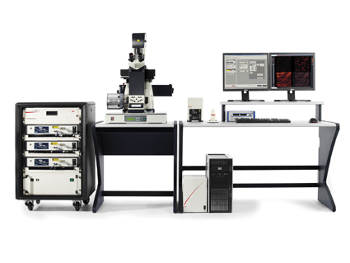The Leica SR GSD 3D super-resolution microscope has been voted third among the Top 10 Innovations 2013 by the prestigious magazine The Scientist. The panel of judges, consisting of representatives from science, business, and the non-profit sector, selected the super-resolution system for 3D localization microscopy from more than 80 entries as one of the most innovative products with the potential to revolutionize life sciences.
 The Leica SR GSD 3D super-resolution system for 3D localization microscopy attains a resolution of 20 nanometers in x and y and up to 50 nanometers in z direction
The Leica SR GSD 3D super-resolution system for 3D localization microscopy attains a resolution of 20 nanometers in x and y and up to 50 nanometers in z direction
The Leica SR GSD 3D enables scientists to visualize and study cellular structures and processes down to the molecular level. It is based on the GSDIM method (Ground State Depletion Microscopy followed by Individual Molecule Return), also known as dSTORM (direct Stochastic Optical Reconstruction Microscopy). Scientists can now study sub-cellular structures and protein-protein interactions, for example the nuclear pore complex, in both 2D and 3D - at highest resolution achievable to date in commercial widefield fluorescence microscopy.
The Leica SR GSD 3D can achieve a resolution of 20 nanometers in the xy plane and 50 nanometers in the z axis. This capability provides new insights into biological systems and their functions, aiding in our understanding of disease processes and contributing to the development of new therapies.
At market launch in September 2013, the Leica SR GSD 3D scored excellent marks with scientists who tested the system and compared it to other imaging instruments. They certified the systems' outstanding precision in localizing single molecules, its system stability, optical performance, and ease of use. These qualities are essential for researchers to obtain reproducible results in the shortest time possible.
"This award highlights the impressive quality and performance of our high-resolution system and its importance for biomedical research - and it is a great reward for the whole team," comments Sebastian Tille, Director of Widefield Imaging, Life Science Division at Leica Microsystems. "We are all the more delighted with this award as the predecessor system had already won several awards for its innovation."
Launched in 2011, the predecessor Leica SR GSD was voted a Top 10 Innovation that year by The Scientist as well as the 2012 R&D100 Award and selected one of three 2012 R&D100 Editor's Choice Awards from R&D magazine. It was also awarded a 2012 Innovations Award by Microscopy Today, the magazine of the Microscopy Society of America.
With many years of experience developing STED (STimulated Emission Depletion) super-resolution technologies based on single point scanning confocal microscopy, Leica Microsystems has again raised the bar in nanoscopy with the Leica SR GSD 3D. The company continues its series of innovations with the new Leica TCS SP8 STED 3X, a confocal platform for 3D super-resolution that was recently presented - together with the Leica SR GSD 3D - at the Annual Meeting of the Society for Neuroscience in San Diego, CA, USA. Both will be shown as well from December 14 to 18 at the Annual Meeting of the American Society for Cell Biology in New Orleans, LS, USA.
About Leica Microsystems
Leica Microsystems is a world leader in microscopes and scientific instruments. Founded as a family business in the nineteenth century, the company’s history was marked by unparalleled innovation on its way to becoming a global enterprise.
Its historically close cooperation with the scientific community is the key to Leica Microsystems’ tradition of innovation, which draws on users’ ideas and creates solutions tailored to their requirements. At the global level, Leica Microsystems is organized in three divisions, all of which are among the leaders in their respective fields: the Life Science Division, Industry Division and Medical Division.
The company is represented in over 100 countries with 6 manufacturing facilities in 5 countries, sales and service organizations in 20 countries, and an international network of dealers. The company is headquartered in Wetzlar, Germany.